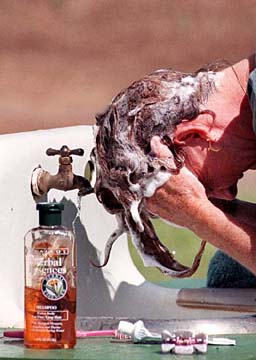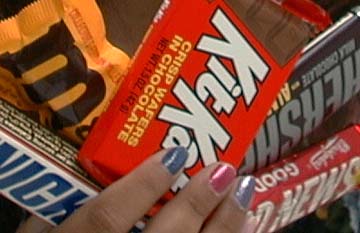

|
Facts of the Matter Richard Brill |
Surfactants have varied,
often subtle usesSurfactants are a broad category of chemicals that each of us uses daily in many different forms, for many different purposes, but are not aware of most of the time.
The term is derived from SURFace ACTive AgeNT, and a surfactant is exactly that. When added to water or other solvent, it acts to reduce the surface tension of the liquid.
This may sound like a menial function, but surface tension, especially where water is concerned, is a major player over the entire range of physical, chemical and biological processes that affect our lives, and in fact drive planet Earth and all its life.
As consumer products, liquid detergents, body washes, shampoos and toothpaste make up a multibillion-dollar industry, mostly using a surfactant called sodium laurel sulfate as a primary ingredient.
STAR-BULLLETIN PHOTO
You'll find surfactants in everyday products such as shampoo....
On a broader scale, surfactants have widespread applications not only in industrial cleaning, but also in designing and manufacturing chemicals, medications and herbicides, extracting contaminants from ground water, cleaning up oil spills, processing minerals and other natural products, including food.
STAR-BULLLETIN PHOTO
... and chocolate candy.
Physically speaking, surface tension is the resistance of a liquid to increase of its surface area, a kind of liquid "clumping" factor. It holds drops of water together and makes them spherical. It makes water flow in tendrils rather than in sheets and makes it possible to create waterproof fabrics that allow air but not water to penetrate. Insects such as the water strider use surface tension to walk on water, and young scientists make paper clips float for science fair projects.
At the atomic level, surface tension is seen as a macro effect of unbalanced electrical forces at the surface of the liquid, the same electrical forces that hold the molecules of the liquid together and keep it from vaporizing.
Within the body of the liquid, there are lots of molecules in all directions, and electrical forces are balanced on the average. A molecule therein surface is pulled equally in all directions by neighboring molecules, resulting in no net force on it.
At the surface it is a different story. Above, there are only a scant few air molecules to counteract the pull of the liquid below. The result is an inward-directed force pulling on a molecule near the surface, ultimately forming an electrical armor that envelops the liquid like an ultrathin skin.
Water molecules near the surface intensify the effect by aligning to form an elastic electrical force field that seals and shields the surface even more. They do this because the shape of the water molecule leaves one end with a slightly positive charge and the other slightly negative. Because of this electrical asymmetry (known as polarization), the negative and positive ends of adjacent molecules attract one another, creating a weak but significant physical bond. Energy is required to stretch and break the bonds, and spreading the liquid requires that some of the bonds be broken.
Substances such as water, sugar and alcohol that are composed of polarized, asymmetrical molecules are known as polar compounds, and water will dissolve them all -- so powerful is its polarity. Water also dissolves ionic compounds such as salt because of its highly polarized nature.
Substances that do not dissolve in water are nonpolar, consisting of molecules that are symmetrical in shape or electrical charge distribution.
The common expression of the distinction between polar and nonpolar compounds is, "Oil and water don't mix." Oil, grease, grime and other nonpolar substances are soluble to varying degrees in nonpolar solvents such as gasoline, toluene and acetone, but these are too harsh and too inflammable for cleaning clothing and people, although other, less harsh nonpolar liquids are used extensively in the dry-cleaning industry.
But oil and water can and do mix, with a little help from surfactants.
A surfactant must be able to emulsify and disperse by lowering the surface tension of both oil and water in order to clean effectively.
But first, both the surface to be cleaned and the soil to be removed must be penetrated so that the oils and dirt particles can be suspended and separated, and kept that way so that the grease and grime will not re-deposit on the clean surface.
Although any asymmetrical molecule dissolved in water will make at least a weak surfactant, designer surfactants used in cleansers are not merely asymmetrical. Each molecule will contain a hydrophilic (water-loving) and a hydrophobic (water-fearing) segment. One end of the molecule is thus polar and dissolves in water, while the other end is nonpolar, avoids water and dissolves in oil and other nonpolar compounds.
When in water, surfactant molecules aim their polar ends at the water molecules, leaving the nonpolar ends sticking out like little electromagnets to attract nonpolar molecules. The effect is like a chemical lint roller that loosens, breaks up and holds onto polar molecules, allowing them to be washed away with the water.
Surfactants also act as wetting agents. With reduced surface tension, water can penetrate through smaller openings by weakening the electrically charged skin of surface tension. A droplet of water placed on a piece of wool will just sit there as if the wool were solid, unable to penetrate the lanolin that coats the wool fibers. Add the smallest amount of liquid detergent to the droplet, and it immediately soaks into the wool. Understandably, wetting agents are used for dyeing woolen fabrics since they allow the dyes to penetrate the fibers.
A wetting agent also increases the adhesion of a liquid to a solid surface by allowing it to spread over a greater surface area. For this reason, surfactants are important components of inks in applications from commercial printing to desktop printers. Wetting agents are also added to paints, dyes and adhesives.
Some surfactants are useful for their foaming properties alone. Others act only as emulsifiers or wetting agents without foaming, while some act to reduce foaming instead.
Today's consumer detergent products for personal and home use add various high-foaming surfactants to satisfy our intuition that foam equals cleaning power. Detergents in early shampoos acquired a lingering bad reputation for being overly harsh because they did not foam and were overused because they lacked the satisfaction that foam seems to provide.
Foaming is not desirable in all situations, however. A foaming product would not be suited for use in automotive windshield washers or in a cleanser for floors.
In mining, a foaming agent is added to a slurry of fine particles, which adhere to the foam and float to the top, leaving the larger particles of waste behind.
Nature has conjured many examples of surfactants, without which life simply could not exist. It is critical that natural oils and fat, collectively called lipids, be carried by water-based fluids such as blood and tree sap. Natural emulsifiers allow the oils to be dispersed in the transporting fluid as well as in individual cells.
Lecithin, a natural emulsifier found in soy and other plants, is a common food ingredient, used in various confections to keep fats and oils from separating. Another common emulsifying surfactant is gum arabic, which comes from the sap of certain species of acacia trees and has been used from the beginning of history 6,000 years ago. The ancient Egyptians used it to prepare inks, watercolors and dyes. Today it is used in foods, beverages, flavorings, pharmaceuticals, cosmetics, printing and textiles as emulsifier, dispersant and wetting agent.
In medical terminology a substance called "pulmonary surfactant" is an essential fluid produced in the lungs that lines the alveoli and smallest bronchioles. It is a complex mixture of lipids and proteins that work together to lower surface tension in the lungs and thus reducing the force required to expand the lung.
Since it is formed relatively late in the fetus, premature infants born without adequate amounts of pulmonary surfactant experience respiratory distress. The condition that results, known as respiratory distress syndrome (RDS), is the fourth-leading cause of infant mortality in the United States. Prior to the 1980s the only treatment was to use a ventilator to inflate the lungs, but surfactant replacement therapy was introduced in the 1980 and has since cut the infant mortality rate from RDS in half.
The breadth of roles and functions served by surfactants both in nature and in the hands of people earn them a place high on the list of the most important chemicals. They are involved in just about everything that has to do with liquids in one way or another, from the nanoscale to the macroscale. Water is the chemical of life and the dominant agent of physical, chemical and biological change on Earth, so surface tension must be credited as the most important and critical mediator of those processes.
It also keeps the dishes and the clothes clean. Take a refreshing pause to ponder that the next time you're breathing while washing the dishes!
Richard Brill picks up where your high school science teacher left off. He is a professor of science at Honolulu Community College, where he teaches earth and physical science and investigates life and the universe. He can be contacted by e-mail at rickb@hcc.hawaii.edu

